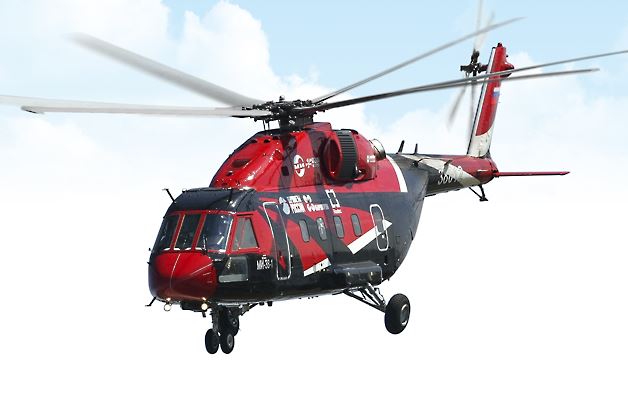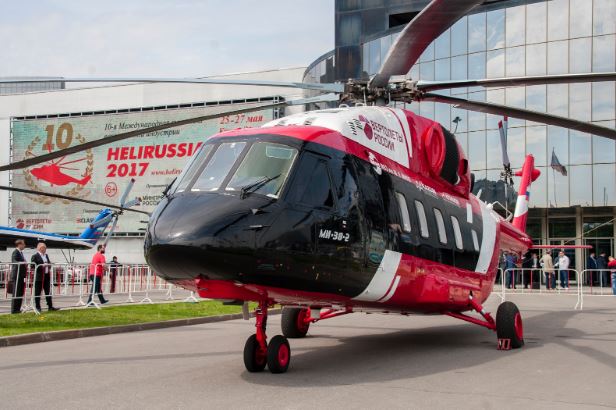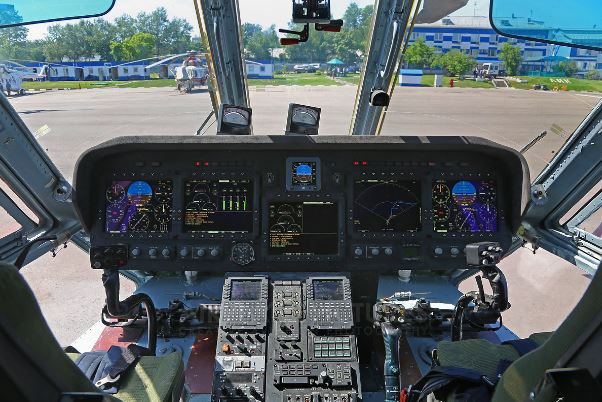Mil Mi-38 Specs, Interior, and Price – Mil Mi-38 is a middle-class multirole helicopter that can carry cargo and passengers, including VIPs. This helicopter can operate in various climates, including the maritime, tropical and cold environments. And it can also operate during the day or night and in environments with temperatures from -60 ° C to + 50 ° C. The first Mil Mi-38 flight took place in October 2004 with a flight of 750km from Kazan to Moscow.
Mil Mi-38 can also be used in various operations, such as missions including utilities, oil exploration, heavy lifting, emergency medical services (EMS), search and rescue operations (SAR), and for offshore missions. So that makes this helicopter the most superior of other helicopters in its class.
The production of the Mil Mi-38 helicopter is carried out by a joint company, the Mil Moscow Helicopter Plant, which is responsible for the development, design, components and testing of flights. The Kazan helicopter, based in Respublika, Tatarstan, is responsible for the manufacture of fuselage, rotor and helicopter assembly. Pratt & Whitney Canada and Pratt & Whitney Russia supply the engine and Thales avionics suite.

Mil Mi-38 has high level default redundancy. Each of the three independent hydraulic systems is capable of controlling the helicopter. The electrical system has three separate AC generators and two batteries. The VD-100 auxiliary unit is installed on the front of the cover.
Mil Mi-38 is capable of meeting various and VIP transportation. It can load up to 30 passengers and has a 5t internal charge and an external charge of up to 7t. The helicopter is equipped with a tricycle type landing gear that still has nosewheel twin wheels and one wheel main unit. The flotation watch is optionally installed for the mission.

The bladder fuel tank is installed under the main cabin floor. Auxiliary fuel tanks can be installed externally for remote operation. Each engine is equipped with an independent fuel delivery system with automatic crossing.
The Mi-38 can fly at a maximum speed of 300 km / hr. The cruise speed is 275km / hour. The normal range and helicopter ferries are 885 km and 1,300 km respectively. The service ceiling is 5,100m. This helicopter weighs around 8,300 kg and the maximum takeoff weight is 15,600 kg.

Integrated avionics include four-channel autopilot, automatic navigation system, weather radar and navigation, vehicle monitoring system and autostabilization system. Most avionics are installed in the avionics compartment between the cabin and the cockpit.
This helicopter is equipped with fly-by-wire controls with manual back-up controls. The powerful flight control system operates in autopilot, autohover, and automatic landing modes.

This cabin has a large flat area that is not blocked by 16m², a large clamshell door with rear loading and a hydraulically controlled and remotely controlled cargo ramp for large and fast cargo loading. A hoist can be mounted above the cabin door on the port side. Roads and doors are equipped with roller conveyers. Powered hoist mounted on overhead rails on the roof of the cabin.
Mil Mi-38 is equipped with cargo slings and can carry up to 7t of external cargo and internal loads of up to 5t with a 29.5m³ cargo area. For cargo transport helicopters are equipped with television cameras and screens to monitor cargo loading and draped loads. The sensor can be installed to check the weight of the load attached and the weight distribution and weight of the load loaded internally.
Hatching on the cabin floor allows tactical cargo to fall from the cabin. Hatches can be replaced with windows and surveillance cameras and other sensor systems for surveillance missions.
Mil Mi-38 can also be used in various operations, such as missions including utilities, oil exploration, heavy lifting, emergency medical services (EMS), search and rescue operations (SAR), and for offshore missions. So that makes this helicopter the most superior of other helicopters in its class.
The production of the Mil Mi-38 helicopter is carried out by a joint company, the Mil Moscow Helicopter Plant, which is responsible for the development, design, components and testing of flights. The Kazan helicopter, based in Respublika, Tatarstan, is responsible for the manufacture of fuselage, rotor and helicopter assembly. Pratt & Whitney Canada and Pratt & Whitney Russia supply the engine and Thales avionics suite.

Mil Mi-38 Specs
Mil Mi-38 helicopter body is mainly of high strength composite construction (conventional pod and boom construction). While the main rotor is made of titanium metal and is equipped with a rotor head with elastomeric bearings. Mil Mi-38 helicopter has six main rotor blades with twisted and over-washed ends and is equipped with an electric ice removal system. The unusual tail rotor consists of two two-bladed tail rotors which are independent on a single shaft. The main titanium rotor head with elastomeric bearings.Mil Mi-38 has high level default redundancy. Each of the three independent hydraulic systems is capable of controlling the helicopter. The electrical system has three separate AC generators and two batteries. The VD-100 auxiliary unit is installed on the front of the cover.
Mil Mi-38 is capable of meeting various and VIP transportation. It can load up to 30 passengers and has a 5t internal charge and an external charge of up to 7t. The helicopter is equipped with a tricycle type landing gear that still has nosewheel twin wheels and one wheel main unit. The flotation watch is optionally installed for the mission.

Mil Mi-38 Engine
Mil Mi-38 is powered by two Pratt & Whitney Canada / Russia PW127TS turboshafts, with 2,500 hp (1,864 kW), equipped with FADEC (full authority digital engine control). Twin engines are installed above the main cabin.The bladder fuel tank is installed under the main cabin floor. Auxiliary fuel tanks can be installed externally for remote operation. Each engine is equipped with an independent fuel delivery system with automatic crossing.
The Mi-38 can fly at a maximum speed of 300 km / hr. The cruise speed is 275km / hour. The normal range and helicopter ferries are 885 km and 1,300 km respectively. The service ceiling is 5,100m. This helicopter weighs around 8,300 kg and the maximum takeoff weight is 15,600 kg.

Mil Mi-38 Cockpit and Avionics
Mil Mi-38 cockpit can accommodate two pilots equipped with an avionics suite developed by Thales with ZAO Transas with five multifunctional color displays. The cockpit is fully air-conditioned. The air conditioner operates with an air compressor on the flight and by an additional power unit on the ground.Integrated avionics include four-channel autopilot, automatic navigation system, weather radar and navigation, vehicle monitoring system and autostabilization system. Most avionics are installed in the avionics compartment between the cabin and the cockpit.
This helicopter is equipped with fly-by-wire controls with manual back-up controls. The powerful flight control system operates in autopilot, autohover, and automatic landing modes.

Mil Mi-38 Interior and Cabin
Mil Mi-38 cabin can be configured for passenger or VIP transportation, cargo or mixed cargo and passenger transportation, air ambulance and emergency evacuation, surveillance and other missions. There is a ramp portide door for passengers. As a passenger transport cabin can accommodate 30 passengers. In the ambulance version, the Mi-38 can accommodate 16 stretchers.This cabin has a large flat area that is not blocked by 16m², a large clamshell door with rear loading and a hydraulically controlled and remotely controlled cargo ramp for large and fast cargo loading. A hoist can be mounted above the cabin door on the port side. Roads and doors are equipped with roller conveyers. Powered hoist mounted on overhead rails on the roof of the cabin.
Mil Mi-38 is equipped with cargo slings and can carry up to 7t of external cargo and internal loads of up to 5t with a 29.5m³ cargo area. For cargo transport helicopters are equipped with television cameras and screens to monitor cargo loading and draped loads. The sensor can be installed to check the weight of the load attached and the weight distribution and weight of the load loaded internally.
Hatching on the cabin floor allows tactical cargo to fall from the cabin. Hatches can be replaced with windows and surveillance cameras and other sensor systems for surveillance missions.
Mil Mi-38 Price
The estimated price of the latest Mil Mi-38 is US $ 13-15 Million.
Mil Mi-38 Specs, Interior, and Price
 Reviewed by Admin
on
01:00
Rating:
Reviewed by Admin
on
01:00
Rating:
 Reviewed by Admin
on
01:00
Rating:
Reviewed by Admin
on
01:00
Rating:






No comments: